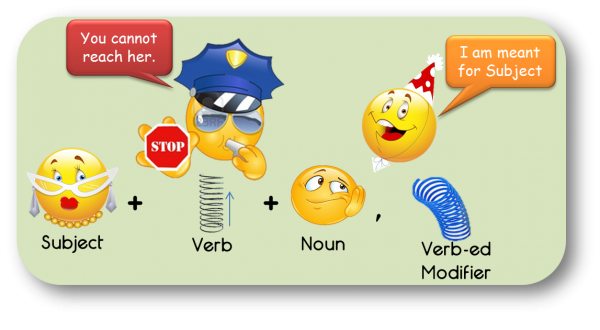
INTRODUCTION:
Generally, a comma + verb-ed modifier placed after a clause acts as an action modifier. Often test-takers wonder, can a comma + verb-ed modifier placed after a clause ONLY modify the subject of the main clause? The answer is No. Generally, this modifier acts as an action modifier that modifies the action in the preceding clause. It may also act as a noun modifier if the context calls for the same. When acting as an action modifier, the comma + verb-ed modifier MUST logically connect with the subject of the modified action; however, this modifier CAN NOT refer only to the subject of the main clause.
Confused about when verb-ed words act as Verbs and when they act as modfiers? Read our article Verb-ed Forms – Verbs or Modifiers
Let us understand this using a simple example:
SIMPLE EXAMPLE :
How the Rule Works
Let’s understand this rule through a simple sentence:
The new spring collection of the renowned designer is expected to hit select stores next month, showcased first by Nordstrom.
The sentence talks about a new collection by a famous designer. It says that the collection will be available in select stores from next month. In addition, Nordstrom will be the first store to showcase the new collection.
The context of the sentence makes it very clear that the comma + verb-ed modifier “showcased first…” should describe the subject “The new collection”. So, is the structure of the above-mentioned sentence correct? Can “showcased first…” from its position modify the subject? The answer is ‘no’.
- Firstly, in such a structure ― comma + verb-ed modifier after a clause ― the comma + verb-ed modifier generally acts as an action modifier. In some cases, this structure may be used to refer to the immediate, preceding noun. However, in the example sentence, none of the modifications make sense because
- The actions “is expected” and “showcased first” do not have any logical connection.
- “showcased first…” is not meant to modify “next month”.
- Secondly, since the main verb of the clause “is expected” is between the subject and the modifier “showcased first…”, the latter CAN NOT jump over the main verb “is expected” to modify the subject “The new spring collection”. So, the sentence is incorrect.
How to correct the example sentence
From the context of the sentence, we understand that the structure “showcased first…” is talking about the subject “The new spring collection”. So, one of the correct versions of this sentence is as follows:
The new spring collection of the renowned designer is expected to hit select stores next month and will be showcased first by Nordstrom.
In the above-mentioned sentence, the comma + verbed modifier has been changed to a verb. This verb now directly associates with the subject and presents logical meaning.
OFFICIAL EXAMPLE:
At e-GMAT, whatever rule we talk about, we back it up the application of the same by an official sentence. So, here it comes.
Many of the earliest known images of Hindu deities in India date from the time of the Kushan Empire, fashioned either from the spotted sandstone of Mathura or Gandharan grey schist.
1. Empire, fashioned either from the spotted sandstone of Mathura or
2. Empire, fashioned from either the spotted sandstone of Mathura or from
3. Empire, either fashioned from the spotted sandstone of Mathura or
4. Empire and either fashioned from the spotted sandstone of Mathura or from
5. Empire and were fashioned either from the spotted sandstone of Mathura or from
This question is taken from OG 2022.
Meaning Analysis
The sentence says that in India, many of the earliest known images of Hindu deities belong to Kushan Empire. The sentence also says that these images are made of either the spotted sandstone of Mathura or Gandharan grey schist.
From the context of the sentence, it is clear that there is no logical connection between the action “date from…” and “fashioned from…”. In fact, both entities present characteristics of these images.
Error Analysis
Since the intended meaning of the sentence is very clear, we can see that the use of the comma + verb-ed is incorrect as it does not connect logically with the action “date from…”. It only described the images.
Moreover, the structure of this modifier ― its placement after the main clause ― prohibits it from jumping over the main verb “date from” to directly modify the subject “Many of the earliest known images”. Grammatically, this modification is not legit. Hence, the original sentence has the modifier error.
P.S.: We will not discuss any other errors in the sentence as the discussion is beyond the scope of this article.
A Quick Check
Incorrect Choices
The vertical scan of the answer choices reveals that the first three choices have the same error that has already been explained in the Error Analysis section. So, Choice A, B, and C are out for the incorrect use of the comma + verb-ed modifier. In Choice D, the verb-ed noun modifier “fashioned from” is preceded by “and” but does not have any entity that it can be parallel to.
The Correct Answer
Choice E indeed is the correct answer for this question. In Choice E, the modifier “fashioned from” has been turned into the verb “were fashioned… from”. As the second verb for the subject, “Many of the earliest known images”, “were fashioned…from”, now presents logical meaning. The SV pair says that these images were from either of the two materials.
Modifiers are one the most commonly tested topics on the GMAT SC. Read our article on What is tested on the GMAT SC to know more about other commonly tested errors on the GMAT SC.
We cover all the concepts required to ace the GMAT SC, starting from the foundations of GMAT grammar in the e-GMAT SC course. We also have 400+ GMAT level practice questions with detailed solutions. Begin your GMAT preparation with our free trial today!
TAKEAWAY:
In GMAT SC, a comma + verb-ed modifier placed after a clause CAN NOT jump over the main verb in the main clause to refer to the subject of the clause.
Want to know about verb-ing modifiers and how they are tested on the GMAT? Read our article on Verb-ing modifiers.













